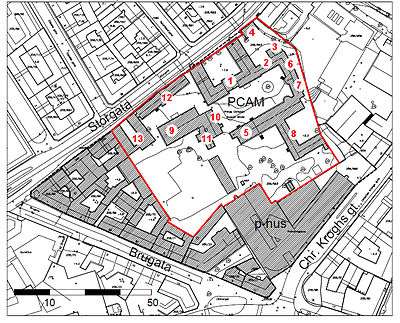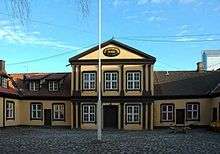Prinds Christian Augusts Minde
Coordinates: 59°54′54.66″N 10°45′22.24″E / 59.9151833°N 10.7561778°E

Red frame = protected area.
Buildings: 1) Mangelsgården main building. 2) Mangelsgården north wing, the dollhouse. 3) Mangelsgården shed. 4) Mangelsgården kitchen/firehouse. 5) The hospital. 6) Christiania asylum. 7) Men's ward of the asylum. 8) Women's ward of the asylum. 9) Factory building. 10) Factory building, church wing. 11) The machine and kettle house. 12) Washery. 13) Basars.
Prinds Christian Augusts Minde is an old asylum, hospital and social institution in downtown Oslo, Norway. The name loosely translates to "Prince Christian August's Memorial".

The oldest building, "Mangelsgården", was protected as a cultural heritage site in 1927. The protection got extended to cover the entire complex in 2009.[1][2]
Mangelsgården was built in 1670-1698. The building was originally raised as a holiday residence with pavilions, dams and fountains. The first known owner was the German general Hans Ernst von Tritzschler (1647-1718). The next owner, general Fredrik Ferdinand Hausmann (1693-1757), built the garden with fish ponds, pavilions and food production. The third owner was general Johan Mangelsen (1694-1769).[3][4]
A group of prominent citizens formed the "Prinds Christian Augusts Minde" charity in 1809, in honour of the Danish Governor-General of Norway, Christian August. The charity was set up to help the poor and unemployed: The number of poor people had increased dramatically in the city, and the prisons were overcrowded. The charity bought Mangelsgården in 1812, and the "Fattigvesenet" (public institution responsible for the poor) spinning factory was moved here. The factory turned into a forced labour camp, with stone cutting, spinning factory, weaving and rope dismantling. The complex got expanded several times. In 1833 the Factory building drawn by architect Christian H. Grosch was erected.[5]
The Aker/Christiania lunatic asylum was moved to Mangelsgården in 1829, and got expanded after the new lunatic asylum laws were passed in 1848. It closed down in 1908.[6]
References
- ↑ The Directorate for Cultural Heritage's protection resolution
- ↑ Oslo City's Cultural Heritage Management Office
- ↑ Wenche Blomberg: Christiania Dollhus - mellom dårekista og asylet. University of Oslo, 2005
- ↑ Wenche Blomberg: Prinds Christian Augusts Minde - historie og visjoner om de fattiges kvartal. Oslo, 2006
- ↑ Research project about Prinds Christian Augusts Minde, the Institute of criminology at the University of Oslo
- ↑ Oslo City Archives about Prindsen